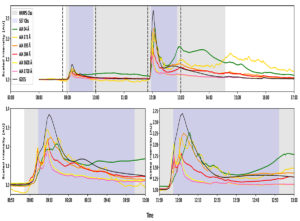New papers: spectroscopy of the Sun and stars
Two new papers that my group contributed to: a study of flares on the Sun, but with the Sun seen as a star, which provides a “translation table” between stellar and solar flare observations; and spectroscopic observation of the great dimming of Beutelgeuse, which happened in 220 and was observed (among others) with the AIP’s STELLA telescope on Tenerife.

A comparative study of two X2.2 and X9.3 solar flares observed with HARPS-N. Reconciling Sun-as-a-star spectroscopy and high-spatial resolution solar observations in the context of the solar-stellar connection
Pietrow, A. G. M.; Cretignier, M.; Druett, M. K.; Alvarado-Gómez, J. D.; Hofmeister, S. J.; Verma, M.; Kamlah, R.; Baratella, M.; Amazo-Gómez, E. M.; Kontogiannis, I.; Dineva, E.; Warmuth, A.; Denker, C.; Poppenhaeger, K.; Andriienko, O.; Dumusque, X.; Löfdahl, M. G., Astronomy & Astrophysics, Volume 682, id.A46, 20 pp. (2024)
Context. Stellar flares cannot be spatially resolved, which complicates ascertaining the physical processes behind particular spectral signatures. Due to their proximity to Earth, solar flares can serve as a stepping stone for understanding their stellar counterparts, especially when using a Sun-as-a-star instrument and in combination with spatially resolved observations.
Aims: We aim to understand the disk-integrated spectral behaviors of a confined X2.2 flare and its eruptive X9.3 successor, which had energies of 2.2 × 1031 erg and 9.3 × 1031 erg, respectively, as measured by Sun-as-a-star observations with the High Accuracy Radial velocity Planet Searcher for the Northern hemisphere (HARPS-N).
Methods: The behavior of multiple photospheric (Na D1 & D2, Mg I at 5173 Å, Fe I at 6173 Å, and Mn I at 4031 Å) and chromospheric (Ca II H & K, Hα, Hβ, and He ID3) spectral lines were investigated by means of activity indices and contrast profiles. A number of different photospheric lines were also investigated by means of equivalent widths, and radial velocity measures, which were then related to physical processes directly observed in high-resolution observations made with the Swedish 1-m Solar Telescope (SST) and the Atmospheric Imaging Assembly (AIA) on board of the Solar Dynamics Observatory (SDO).
Results: Our findings suggest a relationship between the evolving shapes of contrast profile time and the flare locations, which assists in constraining flare locations in disk-integrated observations. In addition, an upward bias was found in flare statistics based on activity indices derived from the Ca II H & K lines. In this case, much smaller flares cause a similar increase in the activity index as that produced by larger flares. Hα-based activity indices do not show this bias and are therefore less susceptible to activity jitter. Sodium line profiles show a strongly asymmetric response during flare activity, which is best captured with a newly defined asymmetrical sodium activity index. A strong flare response was detected in Mn I line profiles, which is unexpected and calls for further exploration. Intensity increases in Hα, Hβ, and certain spectral windows of AIA before the flare onset suggest their potential use as short-term flare predictors.
The Great Dimming of Betelgeuse: the photosphere as revealed by tomography over the past 15 years
Jadlovský, Daniel; Granzer, Thomas; Weber, Michael; Kravchenko, Kateryna; Krtička, Jiří; Dupree, Andrea K.; Chiavassa, Andrea; Strassmeier, Klaus G.; Poppenhäger, Katja, eprint arXiv:2312.02816, accepted for publication in Astronomy & Astrophysics (2024)
Betelgeuse, a red supergiant star of semi-regular variability, reached a historical minimum brightness in February 2020, known as the Great Dimming. Even though the brightness has returned to the values prior to the Great Dimming now, it continues to exhibit highly unusual behavior. Our goal is to study long-term dynamics of the photosphere, including during the Great Dimming. We applied the tomographic method, which allows different layers in the stellar atmosphere to be probed in order to reconstruct depth-dependent velocity fields. The method is based on the construction of spectral masks by grouping spectral lines from specific optical depths. These masks are cross-correlated with the observed spectra to recover the velocity field inside each atmospheric layer. We obtained about 2800 spectra over the past 15 years that were observed with the STELLA robotic telescope in Tenerife. We analyzed the variability of five different layers of Betelgeuse’s photosphere. We found phase shift between the layers, as well as between the variability of velocity and photometry. The time variations of the widths of the cross-correlation function reveal propagation of two shockwaves during the Great Dimming. For about two years after the dimming, the timescale of variability was different between the inner and outer photospheric layers. By 2022, all the layers were pulsating with higher frequency corresponding with the first overtone. The combination of the extensive high-resolution spectroscopic data set with the tomographic method revealed the variable velocity fields in the photosphere of Betelgeuse, for the first time in such detail. Our results demonstrate that powerful shocks are the triggering mechanism for episodic mass-loss events, which may be the missing component to explain the mass-loss process in red supergiants.